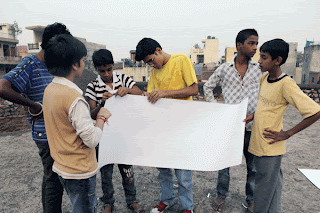Who is Dinesh Chodhary?
 During the search for the missing linkages between Khirkee and its neighborhood surfaced these childhood memories of every adult of the locality, memories of coming to the monument to play, study or just to meet up and chat, and the monument being a part of their lives, even if a dormant one. Still living those memories, 14 year old Dinesh, Ashish, Varun and their friends spend a few hours of their day at the monument daily and feel this unexplainable connection towards it that brings them back to it. The most dominant of the lot, Dinesh Chodhary asserts that he owns the monument. “Yahaan mera Raaj hai.” Like the bats occupying the ceiling of the monument that line the floor with mounds of their dung, the dogs who live in the monument and bark off unwanted visitors, every adult of Khirkee village who has spent a part of their childhood flying kites on the roof of the monument, playing hide and seek or just coming there to contemplate, Dinesh Chodhari is the embodiment of everyone who tends to claim their ownership on the monument in their own little way. Through the 700 years of its existance, people have come and gone and developed and proclaimed their relationship with the monument and different ways each time.
During the search for the missing linkages between Khirkee and its neighborhood surfaced these childhood memories of every adult of the locality, memories of coming to the monument to play, study or just to meet up and chat, and the monument being a part of their lives, even if a dormant one. Still living those memories, 14 year old Dinesh, Ashish, Varun and their friends spend a few hours of their day at the monument daily and feel this unexplainable connection towards it that brings them back to it. The most dominant of the lot, Dinesh Chodhary asserts that he owns the monument. “Yahaan mera Raaj hai.” Like the bats occupying the ceiling of the monument that line the floor with mounds of their dung, the dogs who live in the monument and bark off unwanted visitors, every adult of Khirkee village who has spent a part of their childhood flying kites on the roof of the monument, playing hide and seek or just coming there to contemplate, Dinesh Chodhari is the embodiment of everyone who tends to claim their ownership on the monument in their own little way. Through the 700 years of its existance, people have come and gone and developed and proclaimed their relationship with the monument and different ways each time. And the Dog ate the art..
To see if this 700 year process of the monument’s setting undergoing dynamic change could be scaled down to overnight and replicated, an experiment was carried out. The symbol for the monument, a pink paper square as depicted in the DDA Map (which interestingly the kids identified in no time) was pasted on a white paper context with help from Dinesh and his friends. And the ‘paper Khirkee’ was left on the rooftop overnight under the supervision of the ‘owner kids’. The kids drew and wrote all over, unsurprisingly, Dinesh occupying the centre place. By late evening, as Dinesh recounts, the kids were confronted by a group of drunkards who just wanted to take the ‘Chataai (mat)’. The kids, overpowered and intimidated, pulled the pink monument off the white and ran away. Dinesh says,”baaki sab to phir se banaa sakte hain, yeh phir se kaise bantaa! (Everything else could have been made again, this could have not been!)”. The next morning, the ‘everything else’ was found all over the monument in tatters, some being chewed by the resident dogs. Through the night, the context of the monument kept changing and everyone, from Dinesh to the drunken men and the dogs claimed it in their own ways. But the monument lived on bearing a multitude of associations but still being anonymous and unnamed.
Our personal assumption that the monument stands neglected in the void of time amidst unfamiliar apathetic people was shattered. For what may seem like a perfect case of de-contextualization of the monument to its ever changing context, it was felt that the association of people with the monument was a far more vital linkage to which even the monument lent itself differently through time. The sense of claiming a space rather than actual ownership of it has kept the spirit of the place alive despite the ambiguity in its purpose. In fact, the apparent anonymity reinforces the people’s personal assumptions. In such a controversial and sensitive fabric, the neutral role assumed by the ASI is only helping keep the equilibrium of the place, making room for conflicting convictions to coexist. The beauty of this bustling urban village lies in the Khirkee monument forming a backdrop to all human activity and remaining conveniently untitled for only the better of the community.
Photographs Credits: Vidisha Saini
Photographs Credits: Vidisha Saini




